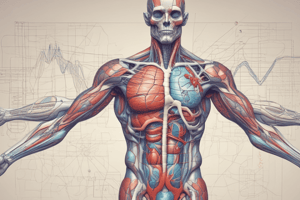Podcast
Questions and Answers
If a healthy young adult male weighs 70 kg, approximately how much of his body weight is comprised of water?
If a healthy young adult male weighs 70 kg, approximately how much of his body weight is comprised of water?
- 28 kg
- 70 kg
- 42 kg (correct)
- 15 kg
Besides water, what are the three major components that make up the remaining 40% of body weight?
Besides water, what are the three major components that make up the remaining 40% of body weight?
- Sugars, nucleic acids, and hormones
- Proteins, fats, and electrolytes (correct)
- Minerals, vitamins and carbohydrates
- Enzymes, blood cells, and antibodies
Which of the labeled functions is NOT a primary importance of water in the body?
Which of the labeled functions is NOT a primary importance of water in the body?
- Serving as a solvent for various processes
- Maintaining the sense of touch (correct)
- Enabling mobility of ions and molecules
- Regulation of body temperature
Considering water's ionizing property, which of the following is a direct result of water's ability to dissociate into ions?
Considering water's ionizing property, which of the following is a direct result of water's ability to dissociate into ions?
Electrolytes play a vital role in maintaining the body's homeostasis. Which of the following functions is a key role of electrolytes?
Electrolytes play a vital role in maintaining the body's homeostasis. Which of the following functions is a key role of electrolytes?
Calcium ($Ca^{++}$) is an important electrolyte in the human body. What is its primary role?
Calcium ($Ca^{++}$) is an important electrolyte in the human body. What is its primary role?
Which of the following best describes how electrolytes contribute to cell membrane potential?
Which of the following best describes how electrolytes contribute to cell membrane potential?
Considering total body water (TBW), a minimum of 40% is required for living organisms. What would be the MOST likely consequence if TBW dropped significantly below this threshold?
Considering total body water (TBW), a minimum of 40% is required for living organisms. What would be the MOST likely consequence if TBW dropped significantly below this threshold?
Which property of water allows it to effectively regulate body temperature?
Which property of water allows it to effectively regulate body temperature?
Given that electrolytes account for 7% of body weight, what would be the approximate electrolyte mass in a person weighing 100 kg?
Given that electrolytes account for 7% of body weight, what would be the approximate electrolyte mass in a person weighing 100 kg?
Considering the distribution of body fluids, what is the primary reason water is distributed into different compartments rather than existing as one uniform solution?
Considering the distribution of body fluids, what is the primary reason water is distributed into different compartments rather than existing as one uniform solution?
Given that water is essential for most sensations except tactile, which physiological process would be MOST affected by severe dehydration?
Given that water is essential for most sensations except tactile, which physiological process would be MOST affected by severe dehydration?
If a patient's electrolyte balance is severely disrupted, leading to an imbalance in osmolarity, what is the MOST likely immediate consequence at the cellular level?
If a patient's electrolyte balance is severely disrupted, leading to an imbalance in osmolarity, what is the MOST likely immediate consequence at the cellular level?
Water's ionizing property ($H_2O \leftrightarrow H^+ + OH^$) plays a crucial role in various physiological processes. Which of the following is the MOST direct consequence of this property?
Water's ionizing property ($H_2O \leftrightarrow H^+ + OH^$) plays a crucial role in various physiological processes. Which of the following is the MOST direct consequence of this property?
Considering the various functions of electrolytes in the body, which scenario would MOST directly result from a deficiency in a specific electrolyte, assuming other factors remain constant?
Considering the various functions of electrolytes in the body, which scenario would MOST directly result from a deficiency in a specific electrolyte, assuming other factors remain constant?
Flashcards
Body Water Percentage
Body Water Percentage
Water constitutes approximately 60% of body weight.
Non-Water Body Composition
Non-Water Body Composition
Proteins, fats, and electrolytes make up the remaining 40% of body weight.
Body Fluid Compartments
Body Fluid Compartments
Body fluids are distributed in major compartments within the body.
Water as a Solvent
Water as a Solvent
Signup and view all the flashcards
Water's Ionizing Property
Water's Ionizing Property
Signup and view all the flashcards
Water and Sensation
Water and Sensation
Signup and view all the flashcards
Water and Temperature Regulation
Water and Temperature Regulation
Signup and view all the flashcards
Water and Tissue Flexibility
Water and Tissue Flexibility
Signup and view all the flashcards
Electrolytes and Osmolarity
Electrolytes and Osmolarity
Signup and view all the flashcards
Calcium's Role
Calcium's Role
Signup and view all the flashcards
Minimum TBW Percentage
Minimum TBW Percentage
Signup and view all the flashcards
Electrolyte Body Weight Percentage
Electrolyte Body Weight Percentage
Signup and view all the flashcards
Electrolytes and Cell Potential
Electrolytes and Cell Potential
Signup and view all the flashcards
What is a solution?
What is a solution?
Signup and view all the flashcards
Study Notes
Body Fluid Distribution Percentages
- Brain, kidneys are composed of 83% water.
- Lungs consists of 85% water.
- Eyes are composed of 95% water.
- Heart, muscles are composed of 75% water.
- Blood consists of 94% water.
Studying That Suits You
Use AI to generate personalized quizzes and flashcards to suit your learning preferences.




